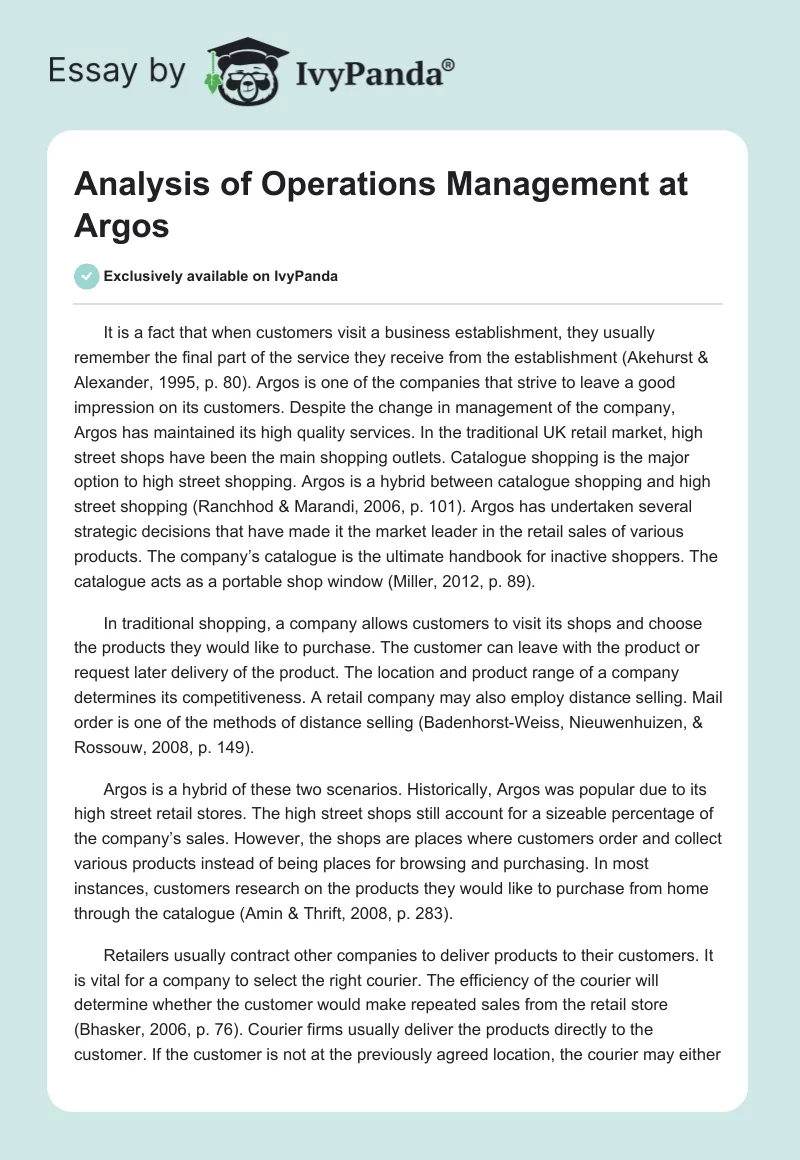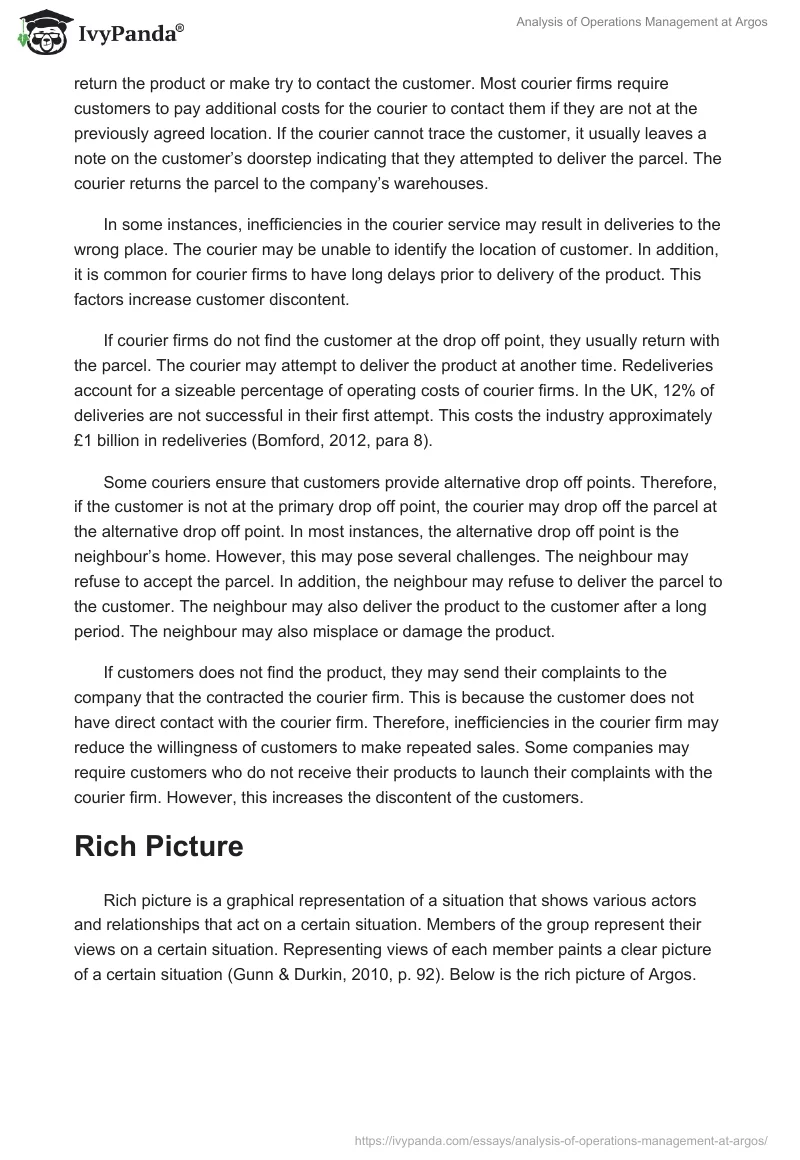It is a fact that when customers visit a business establishment, they usually remember the final part of the service they receive from the establishment (Akehurst & Alexander, 1995, p. 80). Argos is one of the companies that strive to leave a good impression on its customers. Despite the change in management of the company, Argos has maintained its high quality services. In the traditional UK retail market, high street shops have been the main shopping outlets. Catalogue shopping is the major option to high street shopping. Argos is a hybrid between catalogue shopping and high street shopping (Ranchhod & Marandi, 2006, p. 101). Argos has undertaken several strategic decisions that have made it the market leader in the retail sales of various products. The company’s catalogue is the ultimate handbook for inactive shoppers. The catalogue acts as a portable shop window (Miller, 2012, p. 89).
In traditional shopping, a company allows customers to visit its shops and choose the products they would like to purchase. The customer can leave with the product or request later delivery of the product. The location and product range of a company determines its competitiveness. A retail company may also employ distance selling. Mail order is one of the methods of distance selling (Badenhorst-Weiss, Nieuwenhuizen, & Rossouw, 2008, p. 149).
Argos is a hybrid of these two scenarios. Historically, Argos was popular due to its high street retail stores. The high street shops still account for a sizeable percentage of the company’s sales. However, the shops are places where customers order and collect various products instead of being places for browsing and purchasing. In most instances, customers research on the products they would like to purchase from home through the catalogue (Amin & Thrift, 2008, p. 283).
Retailers usually contract other companies to deliver products to their customers. It is vital for a company to select the right courier. The efficiency of the courier will determine whether the customer would make repeated sales from the retail store (Bhasker, 2006, p. 76). Courier firms usually deliver the products directly to the customer. If the customer is not at the previously agreed location, the courier may either return the product or make try to contact the customer. Most courier firms require customers to pay additional costs for the courier to contact them if they are not at the previously agreed location. If the courier cannot trace the customer, it usually leaves a note on the customer’s doorstep indicating that they attempted to deliver the parcel. The courier returns the parcel to the company’s warehouses.
In some instances, inefficiencies in the courier service may result in deliveries to the wrong place. The courier may be unable to identify the location of customer. In addition, it is common for courier firms to have long delays prior to delivery of the product. This factors increase customer discontent.
If courier firms do not find the customer at the drop off point, they usually return with the parcel. The courier may attempt to deliver the product at another time. Redeliveries account for a sizeable percentage of operating costs of courier firms. In the UK, 12% of deliveries are not successful in their first attempt. This costs the industry approximately £1 billion in redeliveries (Bomford, 2012, para 8).
Some couriers ensure that customers provide alternative drop off points. Therefore, if the customer is not at the primary drop off point, the courier may drop off the parcel at the alternative drop off point. In most instances, the alternative drop off point is the neighbour’s home. However, this may pose several challenges. The neighbour may refuse to accept the parcel. In addition, the neighbour may refuse to deliver the parcel to the customer. The neighbour may also deliver the product to the customer after a long period. The neighbour may also misplace or damage the product.
If customers does not find the product, they may send their complaints to the company that the contracted the courier firm. This is because the customer does not have direct contact with the courier firm. Therefore, inefficiencies in the courier firm may reduce the willingness of customers to make repeated sales. Some companies may require customers who do not receive their products to launch their complaints with the courier firm. However, this increases the discontent of the customers.
Rich Picture
Rich picture is a graphical representation of a situation that shows various actors and relationships that act on a certain situation. Members of the group represent their views on a certain situation. Representing views of each member paints a clear picture of a certain situation (Gunn & Durkin, 2010, p. 92). Below is the rich picture of Argos.
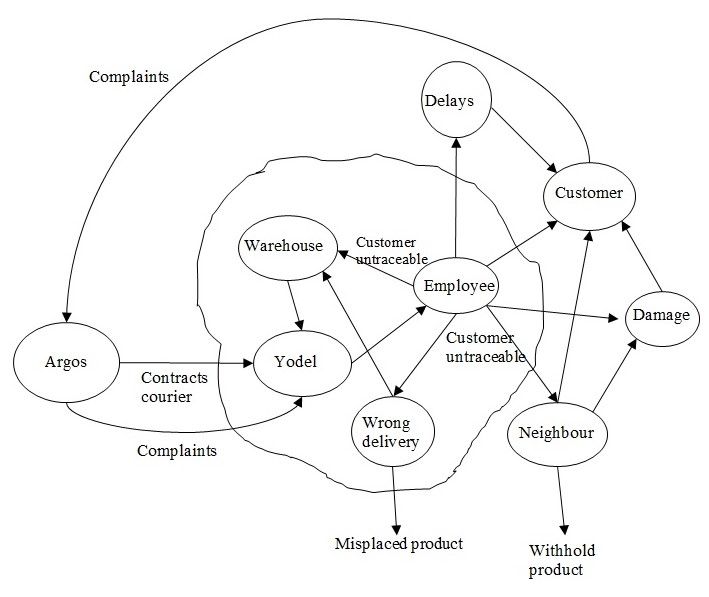
Root Definition and CATWOE Analysis
Root definition gives a contextual definition of how to model a system. There are three elements of a root definition. These include what, how, and why. In a root definition, ‘X’ denotes what a system does. ‘Y’ denotes how the system does it. On the other hand, ‘Z’ denotes why the system does what it does. Therefore, a system should do ‘X’ using ‘Y’ in order to achieve ‘Z’ (Dash, 2010, p. 182) Argos should collaborate with Yodel to develop a system that satisfies customers’ expectations. This root definition may help in the development of a CATWOE analysis. CATWOE denotes, Customers, Actors, Transformation process, Worldview, Owners, and environmental constraints. The following is the CATWOE analysis of the root definition:
- C = people who order products from Argos
- A = Yodel, which is the courier firm that supplies products
- T = development of a system that would increase efficiency of courier operations
- W = ability to supply products cost effectively and on time
- O = Argos
- E = the competitive environment of the retail market
Response to the Parcel Conundrum
Delay in delivering products is one of the major problems that courier firms face. Courier firms may use several strategies to solve this problem. Efficient use of technology would help in solving this problem. GPS technology may help in tracking the location of the customer and the courier (Sabherwal & Becerra-Fernandez, 2010, p. 18). However, use of GPS technology necessitates the company to formulate several security measures that would ensure that it does compromise its information or that of the customer. The company should restrict the time that customers can track the couriers. This would ensure that unscrupulous people do not take advantage of this technology to defraud the company or the customer. In addition, the company should have means of identifying the customer. The company may use face recognition or a PIN number to increase the security of the customer’s parcel.
A courier firm should ensure that customers provide an alternative drop off point. Therefore, if they are not at the primary drop off point, the courier fir may drop off the parcel at the secondary drop off point. Increasing the number of drop off points reduces the need to make redeliveries. The secondary drop off point may be at the neighbour’s home or customer’s relative. Dropping off items at the neighbour’s home increases the social cohesion of a community.
If the courier does not find the customer at home, the company usually returns the goods to warehouses, which may be miles away. This increases the inefficiencies of the courier. Therefore, it is vital for the courier to ensure that they have storage locations that are close to the customer’s location. The courier may collaborate with the contracting company to store undelivered products at a location that is nearest to the customer. This may be the company’s stores or the courier’s warehouses. This reduces the distances that courier firms travel to make redeliveries. This would reduce the environmental impact of the redeliveries.
It is vital for a company to ensure that the inefficiencies of the courier do not affect its operations. Therefore, the company may create a customer feedback system that helps in identifying problems of the courier. The company should enter into a contract with the courier that ensures that the amount of money that company pays depends on the efficiency of the courier. This would motivate the courier to increase its efficiency. This would motivate the courier to formulate an employee compensation plan that takes into consideration the number and ration of successful deliveries of its employees. In addition, the compensation plan should consider the feedback from customers. This compensation plan would motivate employees to ensure that they deliver parcels to customers in time. In some instances, customers find notes on their doorsteps that couriers could not reach them despite being at home when the courier dropped off the note. This leads to unnecessary re-deliveries.
Argos should use information technology to increase the efficiency of its operations. The company should ensure that it tracks the customer, courier, and parcels. This would ensure that customers receive their products in the first delivery attempt. This would increase the management costs of the company. However, this initiative would increase customer satisfaction significantly. Therefore, customers would be willing to make repeated sales from the company’s stores. This would increase the company’s revenue and profitability. In addition, Argos should ensure that customers provide alternative drop off points.
Business Process Plan
All activities of an organisation strive to meet its primary objective. Business process management considers an organisation as a set of coordinated activities that strive to reach a common goal (Briol, 2008, p. 7). Process design, process metrics, process performers, process infrastructure, and process owner are the major factors that ensure a process goes on smoothly (Brocke, 2010, p. 8). An organisation should have leadership, governance, culture, and expertise that would facilitate the process (Dayal, Eder & Koehler, 2009, p. 139).
Business process model strives to produce an abstract of how businesses operate in reality. Business process models achieve this by identifying the major elements that drive business operations (Briol, 2008, p. 9). Business process diagram is one of the models that may illustrate the activities of an organisation. A business process diagram groups processes whose performance is by one entity into a pool (Ardagna, Mecella & Yang, 2009, p. 76). In addition, the diagram partitions a pool into lanes. A lane usually represents a department within the organisation (Daniel, Barkaoui & Dustdar, 2012, p. 421). ‘As is’ business process diagram shows the present business process of an organisation. On the other hand, ‘to be’ shows business process diagram of an organisation after undertaking certain strategic changes in future (Hofstede, Benatallah & Paik, 2008, p. 161).
In the ‘as is’ business process diagram of Argos, the company receives orders from the customers directly. After processing the customer’s order, the company contracts Yodel to deliver the products. If Yodel does not find the customer at the previously agreed location, it returns the product in its warehouses. The courier may make return trips in effort to deliver the parcel.
The ‘to be’ process diagram would ensure the tracking of customers, employees, and parcels. The customer can track the location of the parcel or employee. This enables the customer to be present during the delivery. If Yodel’s employees cannot trace the customer, they may return the parcel to the company’s warehouses or the nearest Argos store. Below is the ‘as is’ and ‘to be’ business process diagram of Argos.
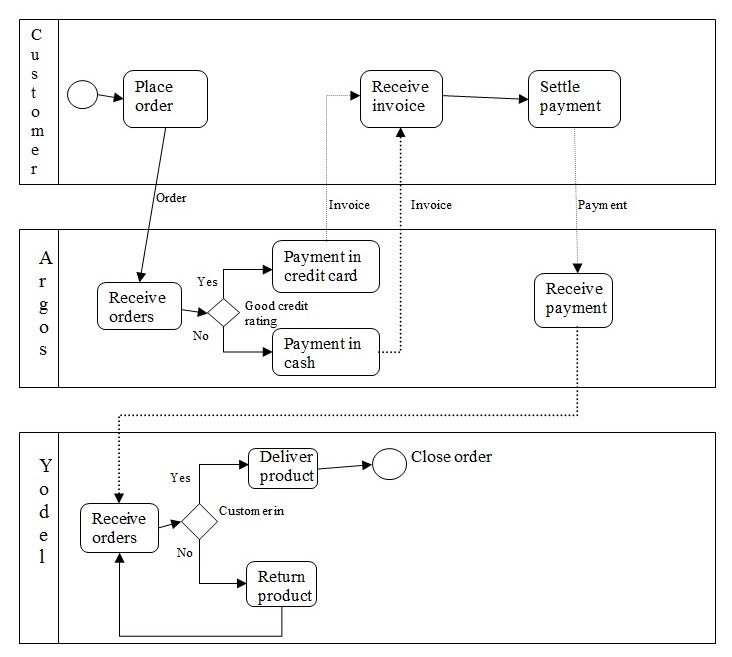
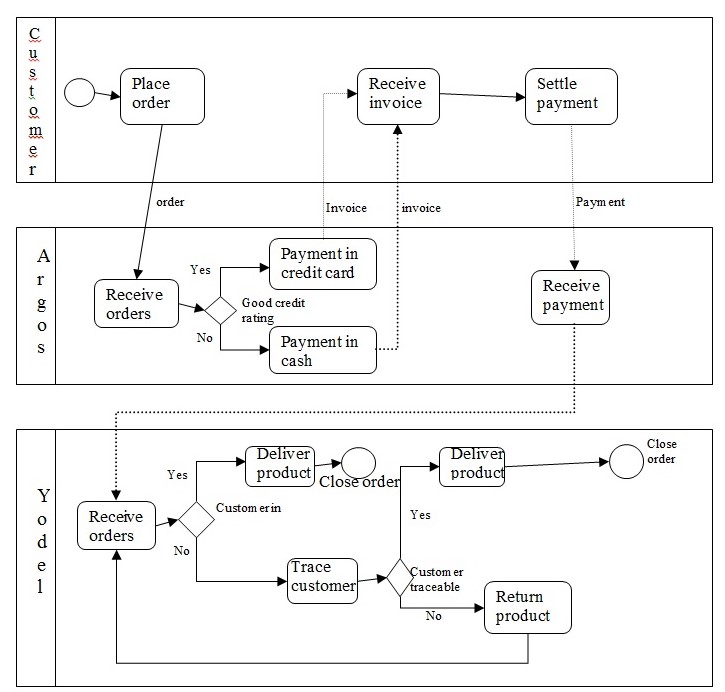
Managerial Capabilities and Resources
Argos intends to use the strategic move to improve its competitiveness. It is vital for the company to have managerial qualities that would facilitate efficient implementation of various qualities. The management of the organisation should have organisation skills that would enable it to identify, manage and measure the achievement of the strategic goals. In addition, the management should have the ability to formulate strategic objectives, measures, and initiatives that would help in efficient implementation of the strategy (Marr, 2010, p. 3).
It is vital for the management of the organisation to demonstrate fairness. Fairness would ensure that employees do not feel that the management is giving them unattainable goals. In addition, fairness would ensure that the management of the organisation treats all employees equally (Aswathappa, 2005, p. 12).
The management of the organisation should be dedicated to continuous improvement. The managers should coach the employees on how to undertake the new process efficiently. Continuous improvement would help in the development of innovative ways of implementing the new process efficiently (Friday & Cotts, 1995, p. 128).
The management must understand the team dynamics that are necessary in efficient implementation of the new process. In the modern business environment, teams undertake most activities (Richardson, 2005, p. 346). Therefore, it is vital for the management of the organisation to understand how the team dynamics function to implement the new process.
For the new process to be a success, it is vital to have management support. Management support would ensure that the new process gets all resources that are vital for efficient implementation. In addition, it is vital for the management of Yodel and Argos to have efficient coordination mechanisms. This would ensure there is early detection and solution of problems in the new system.
Balance Scorecard
The balanced scorecard is one of major methods that companies use to determine the efficiency of various strategies. The balanced scorecard is a deviation from the traditional measure of performance through the socio-financial approach (Onchia & Quagini, 2010, p. 48). Therefore, the balanced scorecard gives a holistic view of the impacts of certain strategic moves (Niven, 2010, p. 233). The balanced scorecard helps in the coordination of various activities that determine the efficiency of an initiative. One of the major advantages of the balanced scorecard is the fact that it brings together the different perspectives of a company’s performance in a single report (Drury, 2005, p. 472).
Organisations present the performance measures in several a large reports. These reports are usually unhelpful since they usually have information overload (Blokdijk, 2008, p. 138). Mapping out the strategy of an organisation in one document facilitates effective internal and external communication of the strategy (Hannabarger, Buchman & Economy, 2011, p. 38).
It is vital for an organisation to determine the performance measures of various strategic moves. The performance measures help in determining whether the company has achieved its objectives. The balanced scorecard provides a comprehensive framework of translating a company’s strategic goals into a clear set of performance measures. Prior to the formation of a balanced scorecard, there is a consensus on various interrelated objectives (Crosson & Needles, 2010, p. 21). This enables the balanced scorecard to create a comprehensive picture of the strategy. The balanced scorecard enables an organisation to determine key performance measures of various strategic moves. Determining key performance measures facilitates high quality management of information (Götze, Northcott & Schuster, 2008, p. 20).
Figure 3.1: Balanced scorecard of Argos
Argos’ new initiative would ensure the tracking of parcels, employees and customers. This would reduce the delivery time and probability of loss of parcels. Operational costs are the performance measures of this initiative. The company strives to use the initiative to reduce the operational costs by 10% in the third year. Tracking of parcels, employees, and customers would also increase the rate of successful first delivery. The company strives to increase the rate of successful first delivery to 100% within three years. This would reduce the number of return trips. Return trips increase the operational costs of the courier (Pride & Ferrell, 2008, p. 58). Improved efficiency of the company would increase the customer satisfaction rating. This would increase customer loyalty (Hayes, 2008, p. 106). The company strives to have a customer satisfaction rating of 100% within three years.
The company would establish an employee rewards program to motivate. The program would help in motivating employees to increase their efficiency. The rewards program would use the rate of successful first delivery and number of deliveries to determine the financial reward that employees would get. Employee satisfaction rating is the key performance measure of this initiative.
References
Akehurst, G & Alexander, N 1995, Retail marketing, Routledge, London.
Amin, A & Thrift, NJ 2008, The Blackwell cultural economy reader, John Wiley & Sons, Hoboken, NJ.
Ardagna, D, Mecella, M & Yang, J 2009, Business process management workshops: BPM 2008 international workshops, Milano, Italy, September 1-4, revised papers, Springer, London.
Aswathappa, K 2005, Human resource and personnel management, Tata McGraw-Hill Education, New Delhi.
Badenhorst-Weiss, H, Nieuwenhuizen, C & Rossouw, D 2008, Business management: A contemporary approach, Juta and Company Ltd., Cape Town.
Bhasker, B 2006, Electronic commerce: Framework, technologies and applications, Tata McGraw-Hill Education, New Delhi.
Blokdijk, G 2008, Balanced scorecard 100 success secrets: 100 most asked questions on approach, development, management, measures, performance and strategy, Lulu, Raleigh, NC.
Bomford, A 2012, ‘The parcel conundrum,’ BBC, Web.
Briol, P 2008, BPMN, the business process modelling: Pocket handbook, Lulu, Raleigh, NC.
Brocke, J 2010, Handbook on business process management, Springer, London.
Crosson, SV & Needles, BE 2010, Managerial accounting, Cengage Learning, Mason, OH.
Daniel, F, Barkaoui, K & Dustdar, S 2012, Business process management workshops: BPM 2011 international workshops, Clermont-Ferrand, France, August 29, 2011, revised selected papers, Springer, London.
Dash, AP 2010, Mergers and acquisitions, I. K. International Pvt Ltd., New Delhi.
Dayal, U, Eder, J, Koehler, J 2009, Business process management: 7th international conference, BPM 2009, Ulm, Germany, September 8-10, 2009, proceedings, Springer, London.
Drury, C 2005, Management accounting for business, Cengage Learning, Mason, OH.
Friday, S & Cotts, DG 1995, Quality facility management: a marketing and customer service approach, John Wiley & Sons, Hoboken, NJ.
Götze, U, Northcott, D, Schuster, P 2008, Investment appraisal: Methods and models, Springer, London.
Gunn, R & Durkin, C 2010, Social entrepreneurship: A skills approach, The Policy Press, Portland, OR.
Hannabarger, C, Buchman, F, Economy, P 2011, Balanced scorecard strategy for dummies, John Wiley & Sons, Hoboken, NJ.
Hayes, BE 2008, Measuring customer satisfaction and loyalty: Survey design, use, and statistical analysis methods, ASQ Quality Press, Milwaukee, WI.
Hofstede, A, Benatallah, B, Paik, H 2008, Business process management workshops: BPM 2007 international workshops, BPI, BPD, CBP, ProHealth, RefMod, Semantics4ws, Brisbane, Australia, September 24, 2007, revised selected papers, Springer, London.
Marr, B 2010, Management white paper: What is a modern balanced scorecard, Advanced Performance Institute, Buckinghamshire.
Miller, D 2012, Material cultures: Why some things matter, Routledge, London.
Niven, PR 2010, Balanced scorecard step-by-step: Maximizing performance and maintaining results, John Wiley & Sons, Hoboken, NJ.
Onchia, S & Quagini, L 2010, Performance measurement: Linking balanced scorecard to business intelligence, Springer, London.
Pride, WM & Ferrell OC 2008, Marketing, Cengage Learning, Mason, OH.
Ranchhod, A & Marandi, E 2006, CIM coursebook 06/07 strategic marketing in practice, Routledge, London.
Richardson, K 2005, Managing organizational complexity: Philosophy, theory and application, Information Age Publishing, Charlotte, NC.
Sabherwal, R & Becerra-Fernandez, I 2010, Business intelligence, John Wiley & Sons, Hoboken, NJ.

